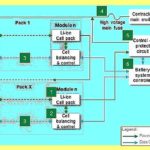 Pickering Interfaces launched a new family of battery simulator modules, ideal for Electric Vehicle (EV) battery stack emulation in Battery Management Systems (BMS) test applications. The 41-752A (PXI) and 43-752A (PXIe) modules enable direct voltage and current readback either programmatically or using Pickering’s soft panel control. Each cell simulator is highly accurate, specified at ±5 mV from 1 V to 7 V.
Pickering Interfaces launched a new family of battery simulator modules, ideal for Electric Vehicle (EV) battery stack emulation in Battery Management Systems (BMS) test applications. The 41-752A (PXI) and 43-752A (PXIe) modules enable direct voltage and current readback either programmatically or using Pickering’s soft panel control. Each cell simulator is highly accurate, specified at ±5 mV from 1 V to 7 V.Targeting EV, automotive, aerospace, energy storage, and electric aircraft applications, the new battery simulator modules occupy a single PXI slot. They are available with two, four, or six battery cell simulators per module that are fully isolated from the ground and from each other facilitating series connections to simulate batteries in a stacked architecture. The 750 V isolation barrier allows the modules to be used to simulate lower power battery stacks that are commonly used for vehicle propulsion. Battery charging emulation is available up to 100 mA.
Each cell provides independent power and sense connections, allowing the simulator to sense a remote load and correct for wiring losses. The battery simulator is designed to respond to dynamic loads, minimizing the need for local decoupling capacitors at the load. The module can also independently read the voltage at the load (via sense lines) and output current for each cell. When supplied with I/V readback, the driver can automatically adjust the module’s output voltage through a feedback system, allowing higher accuracy.
Pickering provides extensive software support for all its products. This support allows users to design their applications with the operating system and programming languages (C/C++, .NET, Python, LabVIEW/LabWindows, MATLAB, etc.) of their choice, making integration to their existing or new system seamless. Users can choose between all Microsoft-supported Windows versions, all popular varieties of Linux, and other hardware-in-the-loop (HIL) operating systems such as VeriStand, LabVIEW RT, and QNX.







Leave a Reply